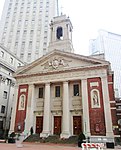Thurgood Marshall United States Courthouse
1930s architecture in the United States1936 establishments in New York CityCass Gilbert buildingsCivic Center, ManhattanCourthouses in New York (state) ... and 10 more
Courthouses on the National Register of Historic Places in New York CityFederal courthouses in the United StatesGovernment buildings completed in 1936Government buildings in ManhattanGovernment buildings on the National Register of Historic Places in ManhattanNeoclassical architecture in New York CityNew York City Designated Landmarks in ManhattanOffice buildings completed in 1936Skyscraper office buildings in ManhattanUse mdy dates from August 2019

The Thurgood Marshall United States Courthouse is a Classical Revival courthouse located at 40 Centre Street on Foley Square in the Civic Center neighborhood of lower Manhattan in New York City. The building, designed by Cass Gilbert and his son, Cass Gilbert Jr., is listed on the National Register of Historic Places as U.S. Courthouse. The United States Court of Appeals for the Second Circuit and the United States District Court for the Southern District of New York hear cases in the courthouse, which is across the street from the Metropolitan Correctional Center, New York City.
Excerpt from the Wikipedia article Thurgood Marshall United States Courthouse (License: CC BY-SA 3.0, Authors, Images).Thurgood Marshall United States Courthouse
Centre Street, New York Manhattan
Geographical coordinates (GPS) Address External links Nearby Places Show on map
Geographical coordinates (GPS)
| Latitude | Longitude |
|---|---|
| N 40.713611111111 ° | E -74.002777777778 ° |
Address
Thurgood Marshall United States Courthouse
Centre Street 40
10007 New York, Manhattan
New York, United States
Open on Google Maps











